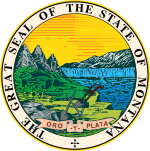
The 1964 United States Senate elections were held on November 3. The 33 seats of Class 1 were contested in regular elections. Special elections were also held to fill vacancies. They coincided with the election of President Lyndon B. Johnson by an overwhelming majority, to a full term. His Democratic Party picked up a net two seats from the Republicans. As of 2023, this was the last time either party has had a two-thirds majority in the Senate, which would have hypothetically allowed the Senate Democrats to override a veto, propose constitutional amendments, or convict and expel certain officials without any votes from Senate Republicans. In practice, however, internal divisions effectively prevented the Democrats from doing so. The Senate election cycle coincided with Democratic gains in the House in the same year.

Timothy Milford Babcock was an American politician, the 16th Governor of the state of Montana, from 1962 to 1969.

Roland R. Renne, an Agricultural Economics Professor, served as President of Montana State College from 1943 to 1964. Dr. Renne was also active in Washington, D.C., and United States overseas agricultural economics work. He was the 1964 Democratic candidate for governor of Montana.
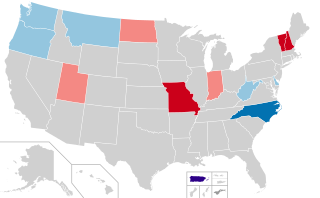
United States gubernatorial elections were held on November 8, 2016, in 12 states and two territories. The last regular gubernatorial elections for nine of the 12 states took place in 2012. The last gubernatorial elections for New Hampshire, Oregon, and Vermont took place in 2014, as Oregon held a special election due to the resignation of Governor John Kitzhaber, while the governors of New Hampshire and Vermont both serve two-year terms. The 2016 gubernatorial elections took place concurrently with several other federal, state, and local elections, including the presidential election, Senate, and House elections.

The 1966 United States Senate election in Montana took place on November 8, 1966. Incumbent United States Senator Lee Metcalf, who was first elected to the Senate in 1960, ran for re-election. He won the Democratic primary uncontested, and moved on to the general election, where he was opposed by Tim M. Babcock, the Republican nominee and the Governor of Montana. Though the race remained close, Metcalf was able to expand on his 1960 margin of victory, and defeated Babcock to win a second term.
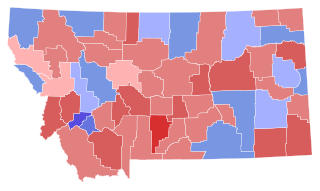
The 1988 Montana gubernatorial election took place on November 8, 1988. Incumbent Governor of Montana Ted Schwinden, who was first elected in 1980 and was re-elected in 1984, declined to seek re-election to a third term, creating an open seat. Stan Stephens, the former president of the Montana Senate, won a close Republican primary, and advanced to the general election, where he was opposed by Thomas Lee Judge, Schwinden's predecessor as governor and the Democratic nominee. Though the general election was hotly contested, Stephens ultimately defeated Judge, becoming the first Republican to win a gubernatorial election in Montana since 1964.

The 1984 Montana gubernatorial election took place on November 6, 1984. Incumbent Governor of Montana Ted Schwinden, who was first elected in 1980, ran for re-election. Schwinden won the Democratic primary against a perennial candidate, and moved on to the general election, where he faced Pat M. Goodover, a State Senator and the Republican nominee. Although then-President Ronald Reagan won the state in a landslide that year in the presidential election, Schwinden defeated Goodover with over 70% of the vote to win his second and final term as governor. This was the last time that Democrats won a gubernational election in Montana until 2004.

The 1980 Montana gubernatorial election took place on November 4, 1980. Incumbent Governor of Montana Thomas Lee Judge, who was first elected in 1972 and was re-elected in 1976, ran for re-election. He faced a stiff challenge in the Democratic primary from his lieutenant governor, Ted Schwinden, and he ultimately lost renomination. Schwinden, advancing to the general election, faced Jack Ramirez, the Minority Leader of the Montana House of Representatives and the Republican nominee. Although Ronald Reagan, the Republican presidential nominee, won the state in a landslide that year, Schwinden comfortably defeated Ramirez to win his first of two terms as governor.
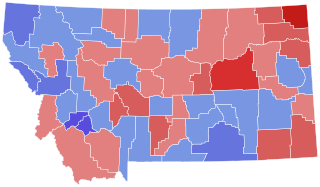
The 1972 Montana gubernatorial election took place on November 7, 1972. Incumbent Governor of Montana Forrest H. Anderson, who was first elected in 1968, declined to seek re-election. Thomas Lee Judge, the Lieutenant Governor of Montana, won a competitive Democratic primary, and moved on to the general election, where he faced Ed Smith, a rancher and the Republican nominee. Although then-President Richard Nixon won the state in a landslide in that year's presidential election, Judge managed to handily defeat Smith, winning his first of two terms as governor.

The 1968 Montana gubernatorial election took place on November 5, 1968. Incumbent Governor of Montana Tim Babcock, who became Governor upon the death of previous Governor Donald Grant Nutter and was elected in 1964, ran for re-election. He faced serious competition in the Republican primary from his Lieutenant Governor, but managed to comfortably win renomination. Advancing to the general election, Babcock faced Forrest H. Anderson, the Attorney General of Montana and the Democratic nominee, and independent candidate Wayne Montgomery of the New Reform Party. Ultimately, Anderson managed to defeat Babcock by a solid margin, winning his first and only term as governor. As of 2023, this is the last time an incumbent Governor of Montana lost re-election.

The 1960 Montana gubernatorial election took place on November 8, 1960. Incumbent Governor of Montana J. Hugo Aronson, who was first elected governor in 1952 and was re-elected in 1956, declined to run for re-election. Donald Grant Nutter, a former state senator, narrowly won the Republican primary, and advanced to the general election, where he was opposed by Paul Cannon, the Lieutenant Governor of Montana and the Democratic nominee. Nutter defeated Cannon by a fairly wide margin, winning his one and only term as governor, as he would die just a year into his term.

The 1956 Montana gubernatorial election took place on November 6, 1956. Incumbent governor of Montana J. Hugo Aronson, who was first elected Governor in 1952, ran for re-election. He was unopposed in the Republican primary and advanced to the general election, where he faced Arnold Olsen, the Attorney General of Montana and the Democratic nominee. Despite the fact that then-President Dwight D. Eisenhower won the state in a landslide that year in the presidential election, Aronson only narrowly defeated Arnold to win his second and final term as governor.
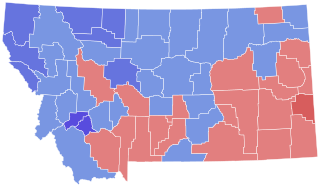
The 1948 Montana gubernatorial election took place on November 2, 1948. Incumbent Governor of Montana Sam C. Ford, who was first elected Governor in 1940 and was re-elected in 1944, ran for re-election. He won the Republican primary and advanced to the general election, where he faced John W. Bonner, the former Attorney General of Montana and the Democratic nominee. Ultimately, Bonner defeated Ford handily in his bid for re-election, winning his first and only term as governor.

The 1944 Montana gubernatorial election took place on November 7, 1944. Incumbent Governor of Montana Sam C. Ford, who was first elected Governor in 1940, ran for re-election. He won the Republican primary and moved on to the general election, where he was opposed by Leif Erickson, a former Chief Justice of the Montana Supreme Court and the Democratic nominee. Although then-President Franklin D. Roosevelt comfortably won the state in that year's presidential election, Ford defeated Erickson by a wide margin to win his second and final term as governor. This election is the first time that an incumbent Republican Governor of Montana was re-elected or won re-election.

The 1940 Montana gubernatorial election took place on November 5, 1940. Incumbent Governor of Montana Roy E. Ayers, who was first elected governor in 1936, ran for re-election. He narrowly won the Democratic primary by just over a thousand votes to win renomination, and advanced to the general election, where he was opposed by Sam C. Ford, a former Associate Justice of the Montana Supreme Court and the Republican nominee. Ultimately, in spite of the fact that then-President Franklin D. Roosevelt comfortably won the state in that year's presidential election, Ford narrowly defeated Ayers to win his first of two terms as governor.

The 1932 Montana gubernatorial election took place on November 8, 1932. Incumbent Governor of Montana John E. Erickson, who was first elected governor in 1924 and was re-elected in 1928, ran for re-election. He won the Democratic primary with a plurality and advanced to the general election, where he faced Frank A. Hazelbaker, the Lieutenant Governor of Montana. Despite the fact that Franklin D. Roosevelt carried the state in a landslide in the presidential election that year, Erickson only narrowly defeated Hazelbaker to win re-election to his third and final term as governor, though he would later resign just a few months into his term to appoint himself to the United States Senate.

The 1928 Montana gubernatorial election took place on November 6, 1928. Incumbent Governor of Montana John E. Erickson, who was first elected governor in 1924, ran for re-election. Erickson only narrowly won the Democratic primary against future Governor Roy E. Ayers, and advanced to the general election, where he was opposed by U.S. Attorney Wellington D. Rankin, the former Attorney General of Montana. Although Herbert Hoover carried the state in a landslide in the presidential election that year, Erickson won re-election to his second term as governor in a landslide over Rankin.

The 1924 Montana gubernatorial election took place on November 4, 1924. Incumbent Governor of Montana Joseph M. Dixon, who was first elected governor in 1920, ran for re-election. Dixon won a competitive Republican primary, and moved on to the general election, where he faced John E. Erickson, a former district court judge and the Democratic nominee; and Frank J. Edwards, the 1916 Republican nominee for governor and the Farmer–Labor Party nominee. Ultimately, Erickson managed to defeat Dixon in his bid for re-election, winning what would be the first of three terms as governor.
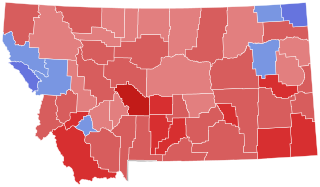
The 1920 Montana gubernatorial election took place on November 2, 1920. Incumbent Governor of Montana Sam V. Stewart, who was first elected Governor in 1912 and 1916, declined to run for re-election. To replace him, former United States Senator Joseph M. Dixon won the Republican primary, which was closely contested. In the general election, he faced Burton K. Wheeler, the former United States Attorney for the District of Montana and the Democratic nominee. Ultimately, Dixon defeated Wheeler by a wide margin to win his first and only term as governor.

The 1916 Montana gubernatorial election took place on November 7, 1916. Incumbent Governor of Montana Sam V. Stewart, who was first elected governor in 1912, ran for re-election. After comfortably winning the Democratic primary, he advanced to the general election, where he faced Frank J. Edwards, the former Mayor of Helena, who narrowly emerged victorious in a close Republican primary. Benefitting from then-President Woodrow Wilson's landslide victory in Montana in the presidential election that year, Stewart narrowly won re-election to his second and final term as governor.

